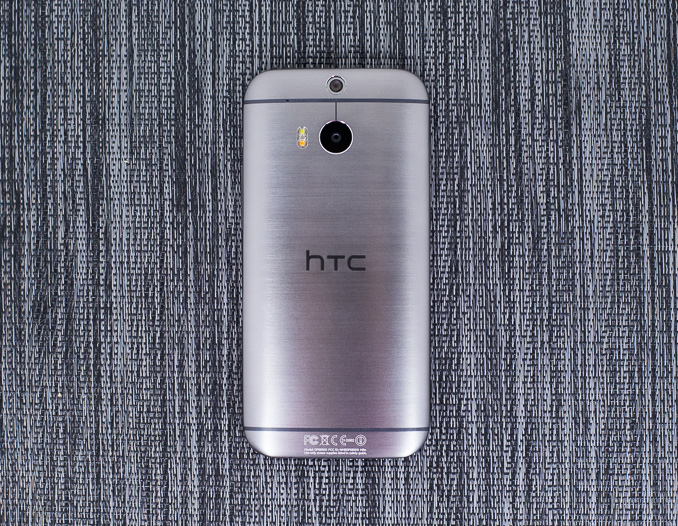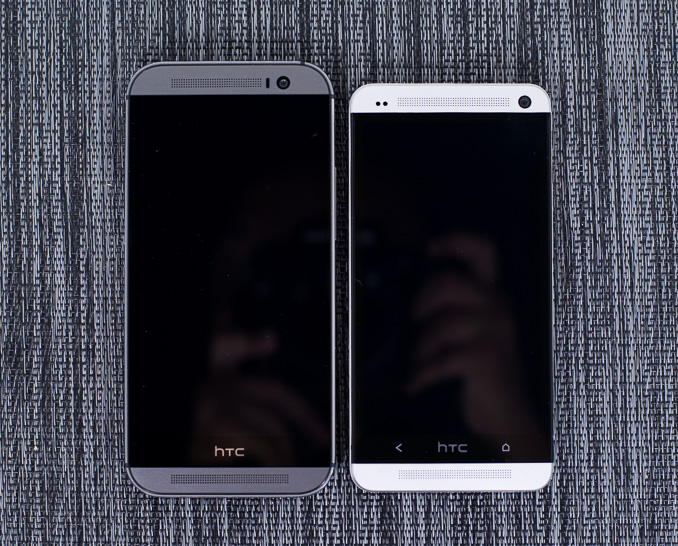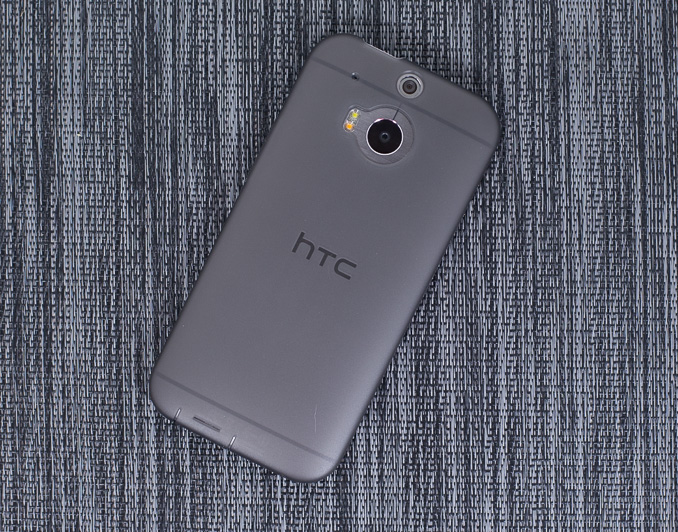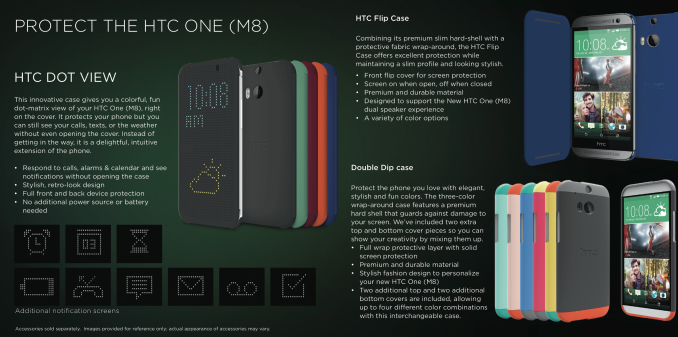The HTC One (M8) Review
by Anand Lal Shimpi & Joshua Ho on March 26, 2014 7:00 PM EST- Posted in
- Smartphones
- HTC
- Mobile
- HTC One

HTC remains one of few Android OEMs insanely focused on design. Even dating back to the origins of the One brand in 2012 with the One X and One S, HTC clearly saw design where others were more focused on cost optimization. Only time will tell which is the more viable long term business strategy, but in the interim we’ve seen two generations of well crafted devices from what would otherwise be thought of as a highly unlikely source. With its roots in the ODM/OEM space, HTC is one of very few ODM turned retail success stories that we’ve seen come out of Taiwan. ASUS is the closest and only real comparison I can make.
As its name implies, the goal of the One brand was to have a device that anyone, anywhere in the world could ask for and know they were getting an excellent experience. Although HTC sort of flubbed the original intent by introducing multiple derivatives (One X, One S, One X+), it was the beginning of relief from the sort of Android OEM spaghetti we saw not too long ago. With the One brand, HTC brought focus to its product line.
Last year HTC took a significant step towards evolving the brand into one true flagship device, aptly named the One. Once again there were derivatives (One mini and One max), but the messaging was far less confusing this time around. If you wanted small you got the mini, if you wanted big you got the max, otherwise all you needed to ask for was the One.
With last year’s One (codenamed M7), HTC was incredibly ambitious. Embracing a nearly all metal design and opting for a much lower resolution, but larger format rear camera sensor, the One was not only bold but quite costly to make. With the premium smartphone market dominated by Apple and Samsung, and the rest of the world headed to lower cost devices, it was a risky proposition. From a product standpoint, I’d consider the M7 One a success. A year ago I found myself calling it the best Android phone I’d ever used.
It didn’t take long for my obsession to shift to the Moto X, and then the Nexus 5, although neither delivered the overall camera experience of the One. Neither device came close to equaling HTC on the design front either, although I maintain Motorola did a great job with in hand feel. Although I found myself moving to newer devices since my time with the One last year, anytime I picked up the old M7 I was quickly reminded that HTC built a device unlike any other in the Android space. It just needed a refresh.
It’s been leaked beyond belief, but in case you haven’t seen it by now this is the M8, the new HTC One:
It’s taller and slightly wider than last year’s model (with a correspondingly larger 5” 1080p display), but all at roughly the same thickness. The all metal chassis is back, but with more metal. If you remove the display and internals, HTC claims the M8 chassis is now 90% metal compared to 70% with the M7. There is a weight impact, but the M8 never feels heavy at 160 grams.
The plastic ring around the M7 is gone, replaced with a single piece of aluminum that curves around the body. With the exception of a strip along the top edge, BoomSound speaker grills and some narrow strips on the back for antennas, the M8 is all metal.
The M8’s surface is a bit smoother than the M7, and there’s now a nice horizontal brushed effect in the gunmetal gray finish. The device is still every bit as wonderful to hold as its predecessor. The design is different, and overall I’d consider it better. For those who care about material feel and design it’s clearly a level above what you see on the market at this price point.
The device will be available in three different colors: Gunmetal Gray (what I was sampled), Glacial Silver and Amber Gold.
HTC also ditched the two fixed capacitive buttons, which was a pain point for some with the M7. Instead we have up to four on-screen buttons at the bottom of the display: back, home, multitasking, and menu as appropriate.
Appearances are meaningless if the device doesn’t have the hardware to back it up, and thankfully the M8 is an upgrade almost entirely across the board. I threw the relevant spec differences into the table below:
| HTC One (2013) | HTC One (M8) | |
| SoC | APQ8064AB 1.7 GHz Snapdragon 600 | MSM8974ABv3 2.3 GHz Snapdragon 801 |
| RAM/NAND | 2 GB LPDDR2, 32/64GB NAND | 2GB LPDDR3, 16/32GB NAND + microSD |
| Display | 4.7” SLCD3 1080p | 5” 1080p LCD |
| Network | 2G / 3G / 4G LTE (Qualcomm MDM9x15 UE Category 3 LTE) | 2G / 3G / 4G LTE (Qualcomm MDM9x25 UE Category 4 LTE) |
| Dimensions | 137.4 x 68.2 x 9.3mm max / 4mm min, 143 grams | 146.36 x 70.6 x 9.35mm max, 160 grams |
| Camera | 4.0 MP (2688 × 1520) Rear Facing with 2.0 µm pixels, 1/3" CMOS size, F/2.0, 28mm (35mm effective), 2.1 MP front facing | 4.0 MP (2688 × 1520) Rear Facing with 2.0 µm pixels, 1/3" CMOS size, F/2.0, 28mm (35mm effective) and rear depth camera, 5MP f/2.0 FFC |
| Battery | 2300 mAh (8.74 Whr) | 2600 mAh (9.88 Whr) |
| OS | Android 4.4 with Sense 5.5 | Android 4.4 with Sense 6 |
| Connectivity | 802.11a/b/g/n/ac + BT 4.0, USB2.0, GPS/GNSS, MHL, DLNA, NFC | 802.11a/b/g/n/ac + BT 4.0, USB2.0, GPS/GNSS, MHL, DLNA, NFC |
| SIM Size | MicroSIM | NanoSIM |
There’s a faster (and more power efficient SoC), a larger battery, and a higher resolution front facing camera. BoomSound gets a new amp and better sounding speakers, there's also a new dual color flash and a well integrated micro SD card slot (one that doesn't require a removable back). If you were pleased with last year’s One, chances are that you’ll be very happy with this one. If, however, you weren’t totally sold on the M7’s 4MP UltraPixel camera there’s a bit of bad news.
The story of last year’s One revolved around HTC’s decision to use a larger format 4MP camera sensor instead of moving to a higher megapixel sensor with smaller pixels. It was a polarizing tradeoff, but one that was somewhat validated by Apple with its choice of maintaining resolution but increasing pixel/sensor size with the 5s. The most obvious fix for those who had issues with the lack of spatial resolution with last year’s One would be to go to a higher resolution sensor, without going as far as Samsung and LG. Unfortunately, without the buying power of a company like Apple, HTC is left to pick from those sensors that are more widely available. In other words, options are limited.
The solution this round was to keep the rear sensor from the M7 (without OIS), and augment it with another rear facing camera module. I’ll get to the use of the second sensor in a bit, but ultimately that’s the going to be the biggest friction point with the new One. Those customers who were happy with the M7’s camera will be pleased this round, but those who wanted a slight bump in spatial resolution will be left wanting more.
Cellular Bands and What’s Launching
I’m aware of seven different M8 SKUs launching today. In the US, AT&T, T-Mobile, Sprint and Verizon are all getting the new HTC One. Verizon had immediate availability in stores 2 hours after launch, while AT&T and Sprint were available online the same day. All three operators should have devices by April 11th. T-Mobile is the exception as it won’t have the M8 in stores until next month.
Google will be taking preorders for the Google Play Edition of the new One today. Despite shipping with GPE Android, HTC claims the GPE M8 will support Duo Cam via HTC’s APIs (perhaps via a modified AOSP camera app?).
As far as I can tell only the AT&T and Google Play Edition SKUs support carrier aggregation. The two SKUs are quite similar from a cellular standpoint, with the AT&T model locking out UMTS band 4 to discourage movement to T-Mobile.
| HTC One (M8) Cellular Band Support | ||||||||
| FCC ID | Operator/Region Target | CDMA Bands | GSM | WCDMA | LTE | CA | ||
| NM80P6B100 | EMEA | - | 850, 900, 1800, 1900 | 850, 900, 1900, 2100 | 3, 7, 8, 20 | - | ||
| NM80P6B120 | AT&T | - | 850, 900, 1800, 1900 | 850, 1900, 2100 | 2, 4, 5, 7, 17 | 4+17, 2+17 | ||
| NM80P6B130 | T-Mobile | - | 850, 900, 1800, 1900 | 850, AWS, 1900, 2100 | 4, 17 | - | ||
| NM80P6B200 | Verizon | 800, 1900 | 850, 900, 1800, 1900 | 850, 900, 1900, 2100 | 4, 7, 13 | - | ||
| NM80P6B700 | Sprint | 800, 1900 | 850, 900, 1800, 1900 | 850, 1900, 2100 | 25, 26, 41 | - | ||
| NM80P6B160 | Canada | - | 850, 900, 1800, 1900 | 850, AWS, 1900, 2100 | 4, 7, 17 | - | ||
| NM80P6B170 | Google Play Edition | - | 850, 900, 1800, 1900 | 850, AWS, 1900, 2100 | 2, 4, 5, 7, 17 | 4+17, 2+17 | ||
With the exception of the Sprint SKU, all of the remaining M8 SKUs feature Qualcomm’s QFE11xx envelop power tracker. In addition, all SKUs with the exception of the T-Mobile and Sprint devices use Qualcomm’s QFE15xx antenna matching tuner. None of the M8s use the CMOS power amps and it’s still too early for the rest of Qualcomm’s RF360 platform. Unfortunately this present refresh comes a little too early for Qualcomm’s next-generation Category 6 LTE 9x35 modem.
Launching with immediate availability in the US and UK, with other regions following in the coming weeks, is an incredibly difficult feat to pull off. It also helps explain why there were so many leaks leading up to today’s launch. The real trick is timing launch availability and sampling so you don’t have operator partners spoiling your launch, but that’s a challenge for another day.
Inside the One’s box you’ll find the usual suspects: earbuds, USB cable and charger. New this round is you’ll find a simple case in your box. The included case is a no frills design, but it’s awesome to find something like that in the box these days.
HTC will gladly sell you one of their Double Dip, Flip or new Dot View cases. The former now includes two sets of top/bottom colors with each case. The Dot View case is interesting as it enables some glance usage models, but without an AMOLED display I’m curious about the power impact.





















222 Comments
View All Comments
berantle - Friday, March 28, 2014 - link
@Death666Angel, it is not a stupid argument. It is a rational reasonable argument.Fundamentally, it is a phone first and whatever else second. Yes, it is capable of other things but it cannot fully replace what other purpose-specific devices do better. Taking into account the size, form factor and the practical realities of smartphones, it is actually pretty foolish to expect that these fully replace the proper devices for it.
The main point about the camera as stated ad nauseum is the camera's resolution is sufficient for what many people use the photos taken from it - i.e. post onto social websites and blogs, and view them on their 1080p (1920x1080) Full HD TV. The 4MP resolution of the HTC One (both M7 and M8) camera equates to 2688 x 1520 images at 16:9 ratio. This size provides more than enough detail for 1080p Full HD TVs that are very common nowadays. Posting on Facebook, Google+, Instagram, Snapchat, etc, the image sizes shown on screen rarely, if ever, go as large as 1920x1080.
Good photos are rarely just about how detailed it shots. It's about picture composition/framing, quality of lenses and proper focusing, and a basic understanding and proper use of photography technicalities. If you're a crap photographer, having a higher number of pixels only means you're likely to be taking crap photos that have more detail.
That all said, personally, 4MP (2688x1520) pictures are at the lower end of my requirements. It would be nice to have a sensor of more 2-micrometer pixels than 4MP. As it is, the 4MP picture resolution of the HTC One camera is adequate for my needs.
Thermalzeal - Friday, March 28, 2014 - link
I don't think it's a broken record. While photo's look similar on a phone's display, they certainly differ in quality when viewed on a higher DPI display. You are right that there is a small audience that appreciates this, but this is a high end product to top off the premium tier of HTC phones. I like the concept of the dual camera, but it would have been nice to get at least a 12MP sensor since they are not really cost prohibitive.Also in the end, you can always down sample a photo, but in the future where bazillionK resolution is the standard, these photo's will look like your mom and dad's black and whites.
evonitzer - Saturday, March 29, 2014 - link
"I like the concept of the dual camera, but it would have been nice to get at least a 12MP sensor since they are not really cost prohibitive."But at what cost in performance? Low light performance will suffer. I do not understand people's difficulty in this minor complexity. The resolution is good enough, and enables greater performance in low light. Daylight shots will lack resolution. We do not need to boil it down any further to "this camera is crap" or "this camera is great". This camera does exactly what it is designed to do and it is up to shoppers to decide if it is right for them.
dimsum888 - Saturday, March 29, 2014 - link
compared to other flagship phones it doesn't perform well. at its price point it is expected all features are comparable to other high end phones.jospoortvliet - Sunday, March 30, 2014 - link
No, compared to other phones it does worse at still pictures with outside day light and better at moving picks and at night. So there is a choice: if you want to take pics inside orat night or of moving objects, the HTC one is best. If you take pics of static objects in good lightning conditions, buy another phone. I know why I prefer my HTC, which makes the better pics in 90% of relevant (for me) circumstances but ymmv.notposting - Monday, March 31, 2014 - link
Or get one of the Lumia's which take better pics both outdoors, indoors, good light, no light, have OIS, have the resolution to allow cropping, some allow for saving a copy in RAW.Between the Note 3, S4/S5, iPhone 5S, Lumia 92x/1020, LG G2, and the Sony lineup, there is basically little reason to choose the HTC if the camera is at all important to you.
augustofretes - Monday, March 31, 2014 - link
The resolution isn't good enough. The detail capture is obscenely poor. People zoom-in their images to see their friends and stuffs in the picture you know? While I agree that 12MP is not really necessary, 8MP + OIS are way a better choice than the nonsense of 4MP + secondary sensor for gimmicky procedures.Blown503 - Monday, March 31, 2014 - link
5 megapixels is an 8x10 picture on paper, 8 megapixels is a 16x20 picture on printed paper. The are printed @ 300 dpi.Chaser - Thursday, April 10, 2014 - link
I've owned the HTC One M7 and if its one area I was disappointed in was its versatility as a point and shoot. Yes the low light level is very good but with larger scale more distance "scenic" outdoor photos there is a difference with the high pixel phone cams. So yes, while a photo of a flower pot on a table may not look "noticeably different" the quality of even smartphone cams vary. I know because I go through flagship smartphones at least once a year sometimes sooner and I use their cameras frequently as I have no desire to carry around an extra camera.Let me make another distinction. If you do take a photo and later desire to crop and resize that photo (and post it on social media for example) the higher pixel cameras won't lose detail like the lower pixels cameras such as my former HTC One would. So enough with the "broken record" about pixels not mattering. I can assure you they do. Even smart phone camera image quality and versatility has improved significantly since two years ago. I sold my HTC One because I was disappointed with it's overall camera quality. I am much happier with my new LG G2's higher pixel camera.
perpetualdark - Wednesday, April 2, 2014 - link
While I agree that the HTC One camera is good enough and even better than other phones in certain situations (ie low light), the megapixel argument does hold water. Unless every picture you take is at standard zoom, the number of pixels in a smartphone is very important. This is NOT a camera with a physical zoom lens on it, so zoom is purely a factor of megapixels. The more pixels you have, the more you can zoom in.Keep in mind, every other camera on smartphones has a smaller lens aperture though, so while you can zoom way in with higher megapixels, you have to have longer exposure to get the same amount of light to the sensor to get the same picture quality, and again the lower the ambient light, the worse the picture. In well lit scenes that are fairly static, an 8 or 16 megapixel camera will be able to zoom way in and get a great picture that is still high resolution even on a 1080p television or monitor. The 4mp might be better in low light and might take great pictures at no zoom, but it cannot touch the zoom capabilities of the higher megapixel cameras. Not without a physical zoom lense, and you aren't going to find that in a smartphone.
Bottom line is that if you like to take a lot of pictures where you need to zoom in, and don't want to always be carrying around a professional grade camera, this isn't the phone for you. And for crying out loud, if you are going to make an argument, at least make a valid one..